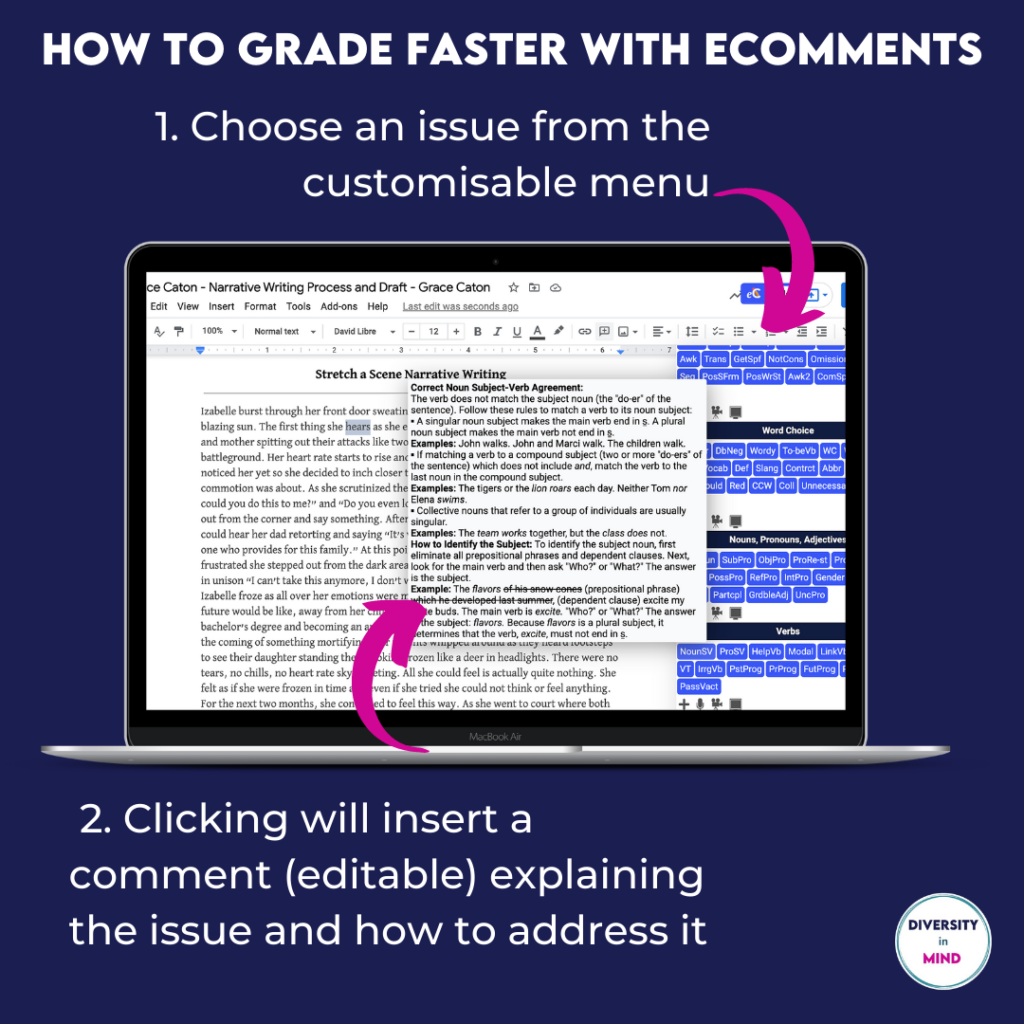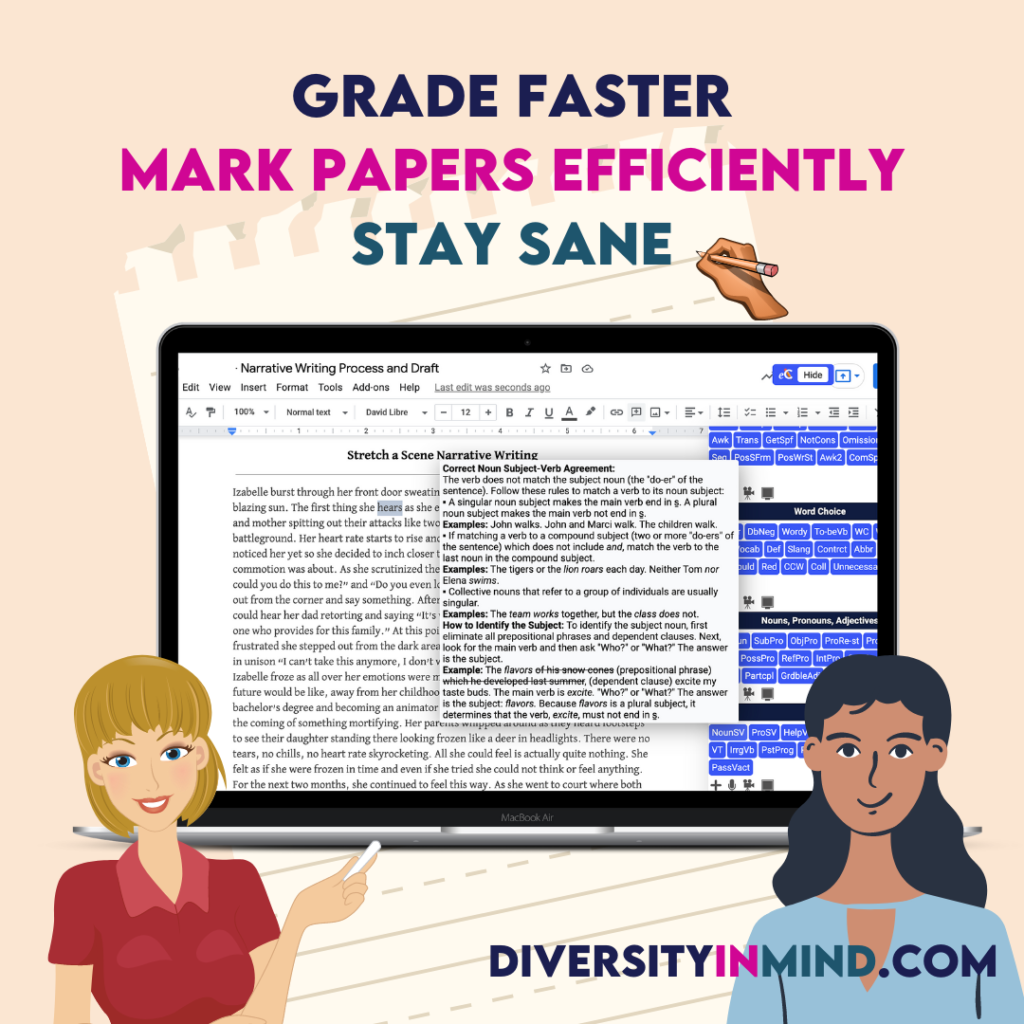Teachers are always looking for ways to grade faster without compromising on quality. I carefully plan classroom time so I spend around an hour grading 20 or so final drafts. In this audio post, I share an overview of my method. Below the video, I briefly summarise the steps I have developed over the years.
Note that I rarely set homework, as too many students don’t do it. We do, however, have half an hour in the school schedule where we can invite students to work with us (4 days a week).
I work in a school with high expectations, over-achievers, and discerning parents. Using this method, I am complimented on my clear and actionable feedback, my students regularly comment on their growing confidence as writers, external assessments indicate at least expected growth, and I do not grade over weekends. I’ve also used this approach in UK state schools with challenging behaviour and under-achievement. If your demographic is different, you might need to make some adjustments. I trust you know your context best but do feel free to connect if you’d like to talk it through.
Grade Faster Step-By-Step
1. Create A Safe Classroom Culture
Create a classroom culture where students feel safe sharing their work. Do this through an explicit focus on developing socioemotional and relationship skills – share with students why you are doing this. Celebrate mistakes as opportunities to learn. Invite ‘stupid’ questions while making clear you don’t believe there is any such thing. Ask students to ask a question that might be on someone else’s mind. This detaches them from the ‘not knowing’ and reduces self-consciousness and embarrassment. If this isn’t possible or hasn’t happened yet, anonymise scripts.
2. Secure Foundational Writing Skills
E-Comments
Hit grammar hard right from the start of the year. I do a short baseline writing – 20 to 30 minutes on a prompt. This should not be a prompt where students are invited to introduce themselves in writing! Seeing your comments all over their heartfelt connection-making may demotivate and damage your burgeoning relationships. Instead, do it on the type of writing you’ll be exploring first. I then use the ecomments Chrome extension to provide feedback on their most pressing issues and then some. This extension allows you to insert comments on language and style at the click of a button. The resulting comment explains what the issue is and how to address it. This will give them independent work time targets for the rest of the year. (Full disclosure – I got the extension free during the beta phase. However, for $30 USD, I’d pay for it many times over for the hours it saves me!) Comment on any given error only once. Make students aware you do this and it is their job to check the whole text for repeats. Remember, whoever is doing the thinking is doing the learning.

It’s worth mentioning 2 other alternatives to e-comments, especially for those who aren’t on Google Docs. In the past, I used the brilliant Laura Randazzo’s 5-Minute Essay Grading System which works wonderfully on paper. Another worth checking out is Ashley’s Fast and Focused feedback. Both of these will save a ton of time with comments so check them out and see what works for you – print or digital shortcuts.
NoRedInk
At the start of the year, I also do a baseline assessment on NoRedInk that generates further targets. The biggest issue I see every year is sentence structure. I therefore set sentences practice including phrases, all sentence types, fragments, and run-ons. I also spend 1 lesson teaching these interactively. Each week, students do a test in class on NoRedInk (so it’s automatically graded). Students ‘test out’ with a score of 90% or more 2 weeks in a row. Then they can read or freewrite while others complete the test. The first week it can take up to 20 minutes. After that, completing the assessment takes less than 10 minutes. Some even finish in less than 5 minutes. If students consistently bomb, I pull them into a small group and teach sentences again. I have yet to meet a student that doesn’t test out before the end of the 1st month of school. As I’m in an international school, I have a high percentage of EAL students. (Truthfully, it’s the EAL students who tend to do best!) Working in an inclusive school, I also have students with learning differences. If they continue to struggle, I may call upon the Learning Support specialist, but I haven’t needed to so far. This process creates competence within the class for informed peer review. Even if there are mid-year arrivals, there are enough students to be able to explain concepts at their level. It’s golden. Furthermore, this experience establishes shared language to discuss errors. Now you can focus on other aspects of writing rather than those time-consuming grammar gremlins.
3. Have Students Deconstruct Mentor Texts
Use mentor texts and have students deconstruct what makes the writing effective. Create/edit the rubric with students including a descriptive summary based on the standards. This summary is a key feature of the feedback comment so it’s of utomst importance. You’ll see why below.
My personal preference for grading papers faster is a 1-point rubric. Whatever you do, ensure the rubric focuses on the most important aspects of the writing. You can’t do it all and I would never have a rubric longer than 1 page.

4. Mini Lessons As They Write
Deliver mini lessons and guided practice on the text features you identified together. Practice, practice, practice. Use apps for self access and automatic grading. Gamify it with tools like Kahoot and Gimkit. Use peer assessment. Hopefully you’ve taken time early in the year to train students on how to provide effective peer assessment.
We also do self and peer editing stations. They vary depending on the writing and the issues we want to address, but an example is below. This one focuses primarily on grammar, but stations can highlight any aspect of writing needed.
5. Whole Class Feedback
Students complete their first draft and do self and then peer review to catch errors and issues as well as celebrate success. Students are never allowed to write on each other’s papers, ever. The person responsible for the writing is the writer. The writer listens, asks clarifying questions, and annotates their own script.
Students can nominate each other as examples of excellence. This means others know to go to these students for peer review on particular aspects of their writing.
Next, students submit their one and only draft. You read them and note common issues according to the rubric. (This takes me less than an hour as I am sticking to the rubric and going ‘big picture’.) If a student has a particularly troublesome issue, I’ll insert/create an e-comment.
Take at least a full class to address these issues with the whole class. Re-teaching may be necessary and – of course – you need some way to check if they now understand. After each issue, stop and allow time for students to apply the learning to their drafts. At this stage, they are not editing (unless you can spare the time). The focus is on annotating and highlighting to edit later. This month, the process took 1 80-minute lesson.
6. Confer With Students
Continue working on the final draft in class time (and at home if possible). Students can ask questions and move between independent writing, peer review, and time with the teacher. You can continue to ‘catch’ issues and highlight achievements for the whole class. For students who struggle to focus, use a Pomodoro timer. (Pomodoro changed my classroom efficiency and my personal work time efficiency by a factor of about 10.)
7. Self Assessment
Before submitting final draft, students highlight the rubric to show what they’ve achieved. They add comments to the rubric, and grade themselves with justification.

8. Super Fast Grading
When it comes to grading, I read their writing followed by their self assessment. By this stage, they are mostly self-aware and their comments are accurate. Where I disagree, I comment. These comments come from the descriptive summary from Step 2 above. It acts as a template I can personalise for the student. Do not be tempted to grade or comment beyond the rubric! If you notice new issues, note them for a later lesson or assignment. This is being true to your students’ efforts, staying in line with best practice around learning, and honouring your precious time.
These comments might seem brief but, in my experience, teens will not read lengthy descriptive feedback much less take action. Added to this is the fact they have the rubric comments too. It is important that feedback is manageable and feeds forward into future learning. Often teachers equate ever-more feedback with higher quality teaching: I disagree. When we give too many feedback points, students become overwhelmed and demotivated. This does not mean we ignore their issues. Instead, we can take note of them to inform our future lessons and guide students toward independent practice.
You’ll also notice I focus more on their achievements than next steps. The next steps come from the rubric comments and descriptors. The 1-point format makes clear where they have/not achieved a competency. We use these in future lessons to set personal writing targets which we continue to work on through free writing and conferring.

And that’s it.
Job done.
Meet a friend.
Have a cup of tea.
Resist the temptation to fill that freed up time with more work!
I hope you found this helpful. If you have questions, reach out any time – I’m happy to geek out with you over my time hacks.
Be well friend – we’ve got this!


